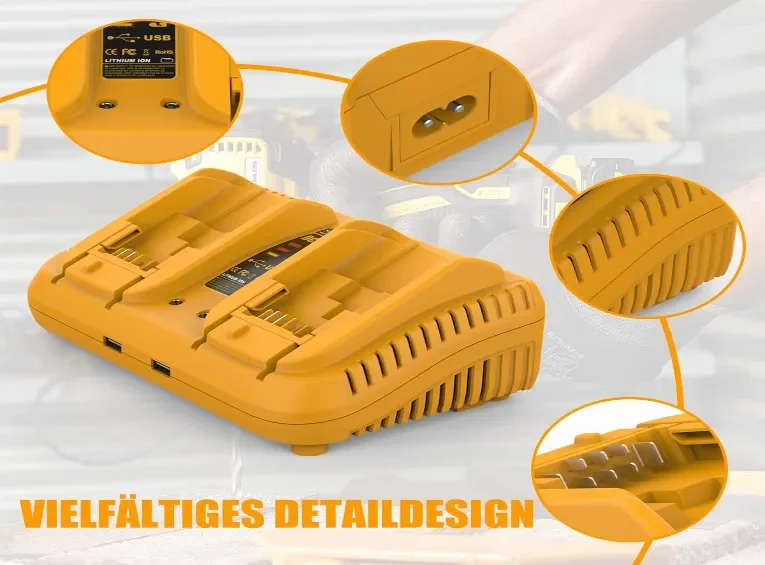DeWalt Charger Safety During Rain, Dust & Harsh Conditions
DeWalt charger safety in harsh conditions relies on shielding from water, dust, and heat while ensuring proper power protection. Always keep chargers elevated, ventilated, and sheltered, using IP54–IP65 enclosures, GFCI/RCD outlets, and surge protection on outdoor sites. Follow a set cleaning cadence with alcohol wipes and filtered airflow, and dry units 24–48 h after exposure before testing. Replace damaged chargers promptly, log faults, and never use passive covers like tarps. Smart setup and routine checks prevent failures, downtime, and safety hazards.

Overview
Chargers fail most often from water, dust, or heat — not from “mystery faults.” With proper shelter, airflow, grounded protection, and a consistent cleaning schedule, you can avoid both downtime and safety incidents.
Core Principles
-
Keep chargers dry, shaded, elevated.
-
Block dust from vents and battery bays.
-
Outdoor circuits require GFCI/RCD + SPD protection.
-
Eliminate pooling water, secure cables overhead.
-
Inspect, clean, and log faults on schedule.
Jobsite Setup
-
Use canopies, ventilated boxes, or rain-rated cabinets — never leave exposed.
-
For harsh sites, go beyond DIY covers: use IP54 enclosures minimum; IP65+ for constant spray/dust.
-
Place chargers on raised trays, not concrete floors (condensation risk).
-
Leave 10–15 cm clearance around vents; avoid stacking multiple chargers.
-
In hot/dusty jobs, add swappable mesh filters or a fan; never trap heat inside sealed boxes.
Power & Protection
-
GFCI/RCD is mandatory outdoors; SPDs protect against generator spikes or lightning.
-
Use short, heavy-gauge cords; thin extension cables create heat and voltage drop.
-
Weatherproof outlets should have gasketed covers; cable entries need strain relief.
Dust Control & Filters
| Site Condition | Recommended Protection | Cleaning Interval |
|---|---|---|
| Mild dust (indoor fit-out) | IP20–IP54, light brushing | Weekly |
| Cutting / grinding zones | IP54+ with mesh/foam filters | Daily wipe + weekly deep clean |
| Extreme cement/gypsum dust | IP65 cabinet + filter tray | Daily replacement |
-
Wipe battery contacts with ≥90% isopropyl alcohol when residue builds.
-
Compressed air only at low pressure, 15–20 cm distance to avoid forcing dust deeper.
Temperature & Operation Rules
-
Normal charging band: 5–40 °C (41–104 °F).
-
Cold packs resist charging — forcing them risks lithium plating.
-
Hot packs accelerate cell wear and stress charger capacitors/transformers.
-
Stagger fast-charging cycles on hot days; allow natural cooling before recharge.
Maintenance Cadence
Daily (Pre-shift)
-
Visual check: moisture, dust, cracks, GFCI reset.
-
Quick wipe of terminals, confirm airflow clearance.
Weekly
-
Clean contacts with isopropyl alcohol.
-
Inspect cords, plugs, vent filters.
Monthly
-
Check spring tension, latch wear.
-
Run one control charge, log time-to-full vs baseline.
-
Summarize LED or error-code frequency in crew log.
Rain or Dust Event Response
-
Cut power and unplug.
-
Remove battery; move both to ventilated shelter.
-
Air-dry 24–48 h; no shortcuts with heat guns.
-
If submerged, or if smoke/odor is present → retire and tag.
-
After drying, test with a known-good charger/battery on a GFCI-protected outlet.
Quick Fault Guide
| Symptom | Likely Cause | Action |
|---|---|---|
| No LEDs | Outlet/fuse/PSU issue | Retire if unresponsive after swap-test |
| Solid red LED | Aging pack / capacitor fault | Retire pack or service charger |
| Error LEDs after drying | Persistent internal moisture/damage | Swap-test → retire if repeat |
| Sparking contacts | Dust, worn springs | Clean & inspect; retire if unresolved |
Extreme Dust / Heavy Exposure Measures
-
Relocate charging indoors/trailer or use sealed IP65 cabinets with filtered airflow.
-
Place trays below chargers to collect falling debris.
-
In mining/concrete sites, replace springs or sockets pre-emptively before fatigue failures occur.
Emergency & Safety Checklist
-
Smoke/fire → evacuate, call emergency services.
-
Wet, no smoke → unplug, air-dry 24–48 h, then test.
-
Overheat/swelling/odor → isolate on non-combustible surface, tag “DEFECTIVE.”
-
Arcing/flashing → stop use immediately; remove from rotation.
Two-Line Pre-Shift Quick Check
-
Station: shelter ✓ airflow ✓ GFCI ✓ cords intact ✓
-
Batteries: no swelling ✓ clean contacts ✓ log updated ✓
FAQs
Q: Can I keep using a charger caught in the rain?
A: Only after unplugging, drying for 24–48 h, then testing with a known-good pack. Any lingering odor/heat → retire.
Q: Is a tarp enough cover?
A: No. Tarps trap condensation. Use ventilated, rigid covers or cabinets.
Q: Is IP54 protection sufficient?
A: Yes for light rain under shelter. For hosed-down or constant exposure, IP65+ is the safe choice.
One-Paragraph Summary
DeWalt charger safety in rain, dust and heat comes down to location, protection and discipline. Keep units elevated, sheltered and ventilated; use GFCI/RCD plus surge protection outdoors. Adopt a daily/weekly/monthly cleaning cadence, and dry for 24–48 h after exposure. Never bypass LEDs or fault codes: swap-test or retire faulty units. Simple upgrades like IP65 enclosures, filter pads and performance logs prevent downtime and protect crews from fire or shock risk.